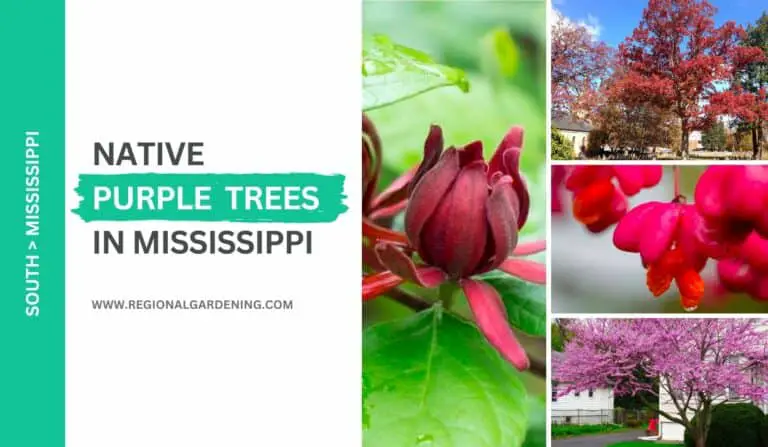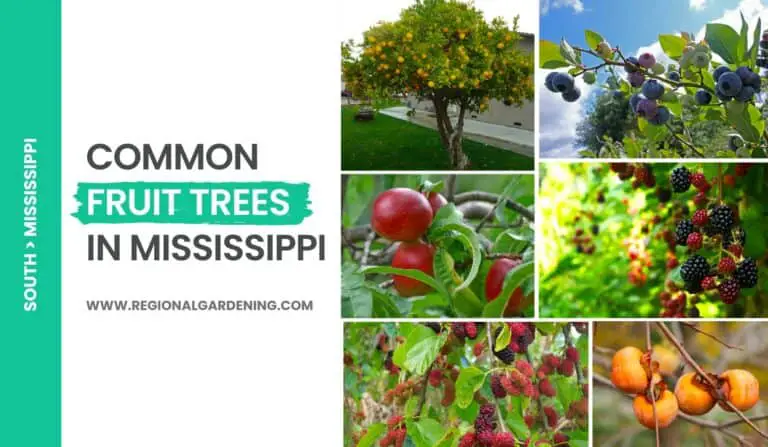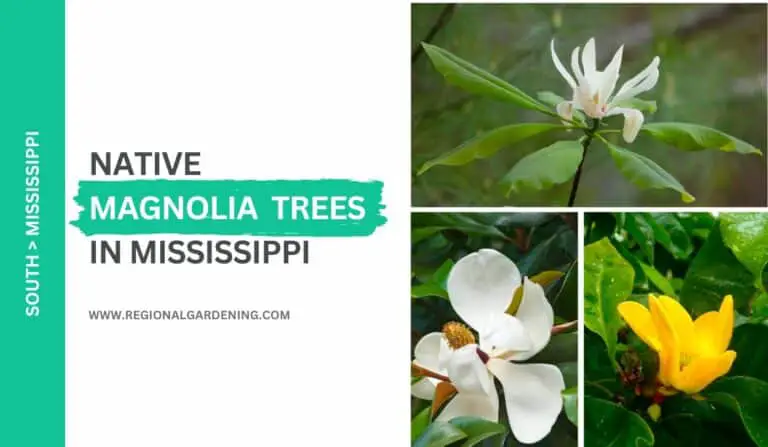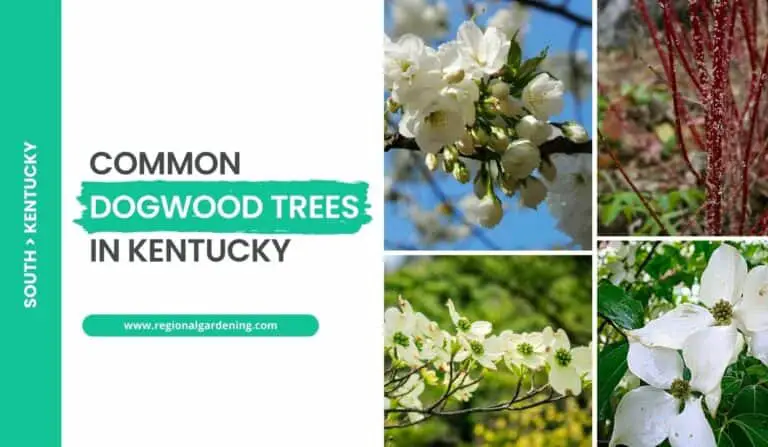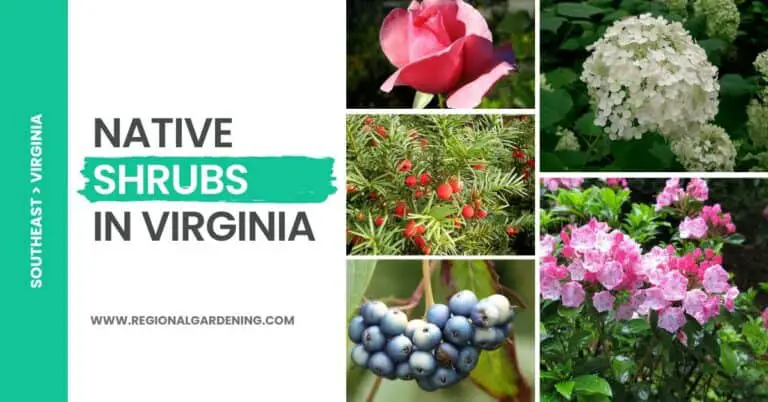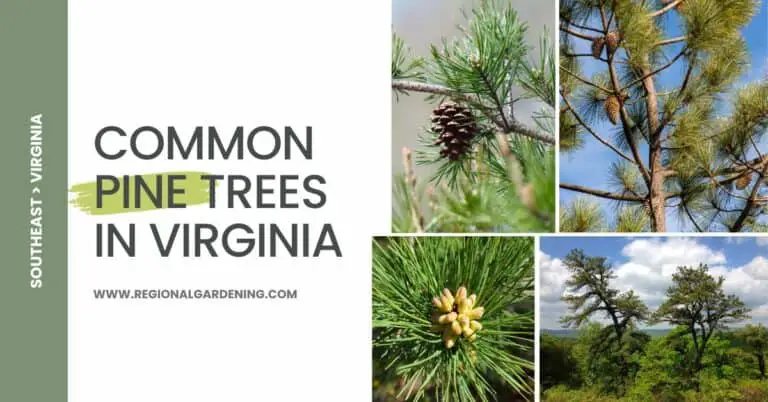3 Common Cedar Trees In Virginia (Pictures & Identification)
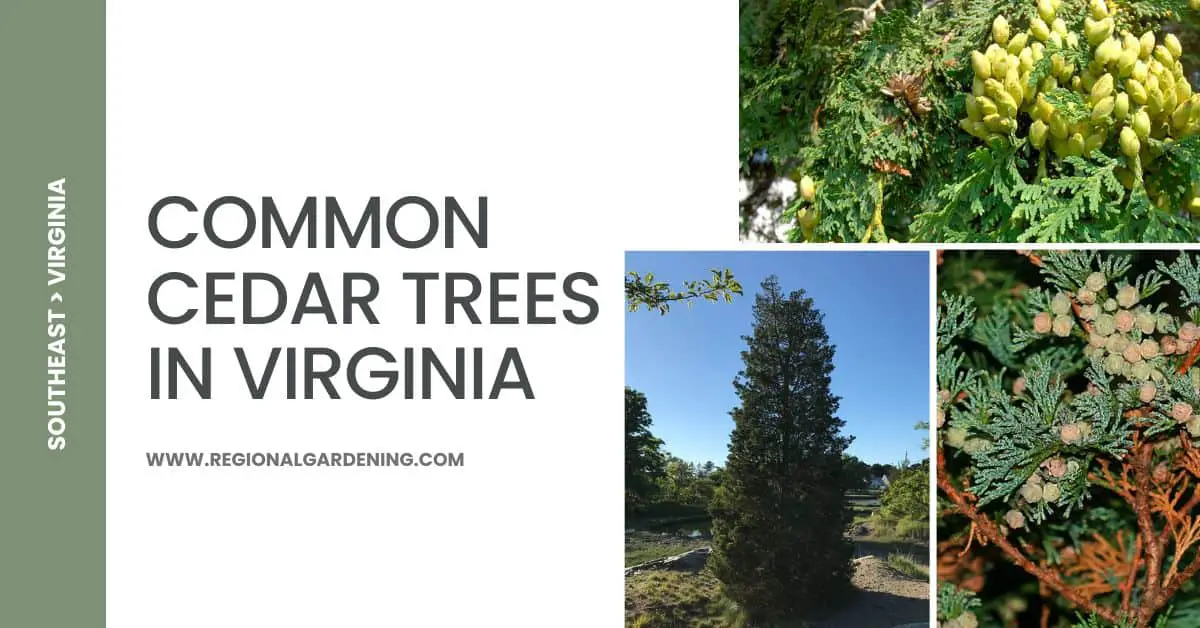
You may have driven through Virginia and not noticed the stately red cedar trees along the roads. Isn’t?
Virginia is home to more than 350 different types of trees, including some varieties of cedar trees. In this article, we’ll be looking at three of the most commonly seen cedar trees in Virginia: the Eastern Red Cedar, the Atlantic White Cedar, and the Northern White Cedar.
All of these trees have different looks and ways of growing, which makes them useful in many different outdoor situations. We’ll go over the characteristics of each tree, including how it looks, what it’s good for, and some of the ways it can be put to use.
So, let’s get started.
1. Eastern Red Cedar
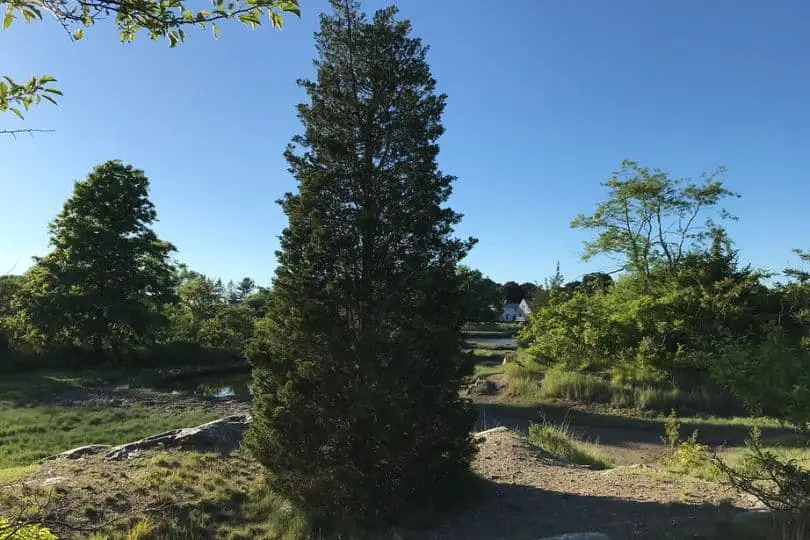
- Scientific Name: Juniperus virginiana
- Common Name: Eastern Red Cedar
- Height: 40-60ft
- Width: 1-2ft
- Native: Eastern US
- Flower: Yellow brown(M) & light blue(F)
- Fruit: Small berries
- Uses: furniture, fence posts, etc
The Eastern Redcedar is a hardy evergreen tree that can grow up to 40 to 60 feet tall and 1 to 2 feet in diameter.
It has a dense, compact crown with short, thin branches and 1/16-inch-long, fragrant needles when they are fully grown. The young needles are sharp and up to 3/8 inch long.
Male trees have small yellow-brown flowers in large clusters, while female trees make light blue-green cones that turn blue when they’re ready and have a grayish-white waxy coating. It has thin, reddish-brown bark that is easy to peel away from the trunk to reveal layers of fibers. The twigs of this species are green and scaly for a few years before turning brown.
It’s important to keep in mind that Eastern Redcedar and apple orchards can be alternate hosts for the Cedar Apple Rust fungus, which can cause spots on the leaves and fruits of both trees.
Red cedar wood is highly valued because it is soft but strong and has an even texture. When finished properly, the contrast between the red heartwood and the white sapwood makes for striking effects.
It can also be used for fence posts, poles, cabinets, rustic furniture, closet linings, pet bedding, and so on. Additionally, its natural oils keep insects away so well that they were used to make pencils before incense cedar took its place.
The berries that grow on these trees give gin its distinctive flavor. They also feed many birds, like waxwings, bobwhites, quail, etc. Deer use the foliage in the winter, while birds find shelter under its dense canopy, which is a great place to sleep and nest at the same time.
Last but not least, Eastern Redcedars help keep soil from washing away.
2. Northern White Cedar
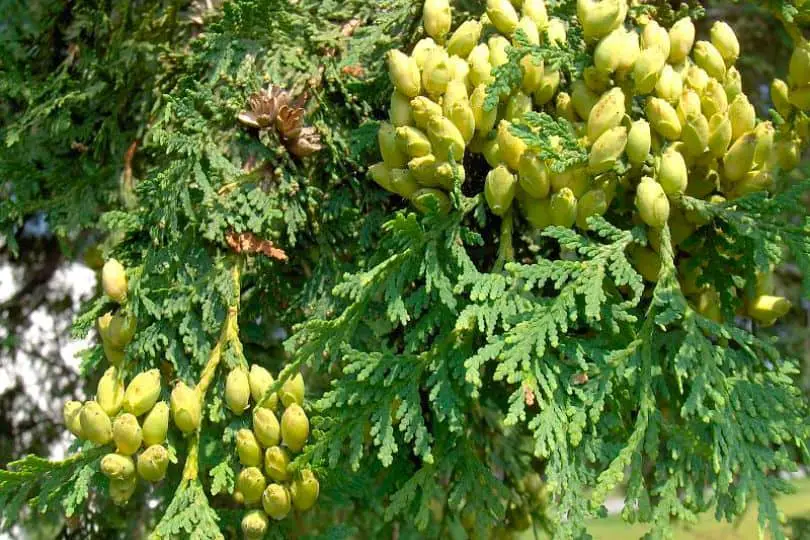
- Scientific Name: Thuja occidentalis
- Common Name: Eastern Arborvitae
- Height: 40-70ft
- Width: 1-3ft
- Native: Eastern US
- Flower: Green with brown tips
- Fruit: Round cones
- Uses: furniture, fence posts, etc
A magnificent evergreen tree, Northern White Cedar can attain heights of 40 to 70 feet and widths of 1 to 3 feet. It features a uniform, pointy crown with short horizontal branches, resembling an arrowhead.
Its bark is reddish-brown, turns gray with age, and is ridged in a diamond pattern, while its branches are covered with green scales that turn brown with age.
The needles are scale-like, 18 to 14 inches long, and aromatic when crushed. And the branchlets flatten into fan-like sprays, and the flowers can be spherical, green with brown tips, or green with 4 to 6 scales, depending on gender.
Native Americans prepared tonic tea from its vitamin C-rich bark and needles, which is supposed to have saved Jacques Cartier and his crew from scurvy.
This wood is light brown, soft, brittle, coarse-grained, and strong, and it smells good. It is perfect for making fence posts, logs, shingles, and other things. Furthermore, white cedar stands are home to many birds and small mammals all year, and deer enjoy eating the leaves.
This species prefers cool, wet organic soils such as stream banks. However, they are commonly seen in backyards and front yards due to their evergreen leaves. It can be very ornamental if properly pruned.
3. Atlantic White Cedar
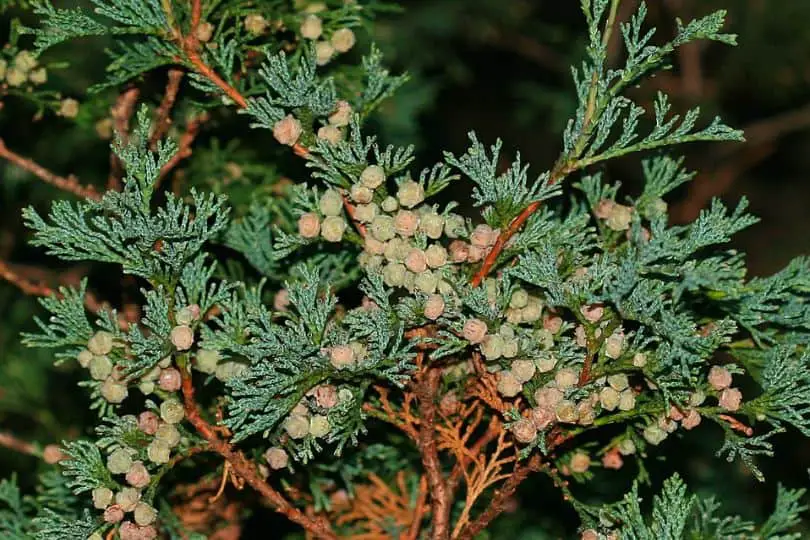
- Scientific Name: Chamaecyparis thyoides
- Common Name: Atlantic White-cedar (Juniper)
- Height: 40 to 85 feet
- Width: 2 feet
- Native: Northeastern US
- Flowers: Red to yellow (M), green (F)
- Fruit: Blue or purple
- Uses: shingles, posts, woodenware, barrels, interior finishes, and boat construction.
The Atlantic White Cedar, or Juniper, is a magnificent evergreen tree that can reach 40 to 85 feet tall and 2 feet in diameter.
It has a short, horizontal crown that is narrow and pointy.
It produces both male and female flowers. Male flowers are red or yellow, and female flowers are green. Both types of flowers are very small.
This plant grows in wet, muddy depressions, swamps, and along the sides of streams where there is fresh water. It often grows in large groups called “glades.”
It has dark blue-green needles that are 1/8 inch long and scaly. When pressed close to the branch, they overlap and give off a pleasant smell when crushed.
Cones are 14 inches wide and either blue or purple. They have a waxy, grayish coating that looks kind of crumpled and turns reddish brown in the fall.
The bark is a light reddish-brown color and comes off in long, fibrous strips. The twigs are green and have tight scales that turn brown as they age.
Atlantic white cedar wood is very strong, has a fine grain, and smells a little bit when it gets wet. This makes it perfect for roofing, posts, barrels, finishing the inside of boats, etc.
Also, its glades provide shelter for many wetland wildlife species. However, heavy harvesting in the early 1900s greatly reduced this species’ range. So, if you have enough space to grow the Atlantic White Cedar tree, then you are helping nature conserve this majestic tree.
Similar Articles
- 14 Common Native Oak Trees In Virginia
- 6 Purple Trees In Virginia
- 4 Common Native Hickory Trees In Virginia
- 5 Common Native Maple Trees In Virginia
- 3 Common Birch Trees In Virginia
- 8 Native Pine Trees In Virginia
- 9 Common Nut Trees In Virginia
- 3 Native Elm Trees In Virginia
- 2 Native Ash Trees In Virginia
- 7 Native Evergreen Trees In Virginia
- 8 Native Flowering Trees In Virginia
- 2 Common Locust Trees In Virginia
- Common Palm Trees In Virginia
- 6 Pink Flowering Trees In Virginia
Cedar Trees In Virginia – Frequently Asked Questions (FAQs)
Here are the most commonly asked questions about cedar trees in Virginia.
Do cedar trees grow in Virginia?
Virginia is home to a thriving cedar tree population. The Atlantic White Cedar, Northern White Cedar, and Eastern Red Cedar are all native to Virginia and are three of the state’s most common cedar trees. Each species can be identified by its shape, leaf structure, and how it grows and changes over time. Cedar trees are not only a nice addition to the landscape, but they also help keep the environment healthy by giving shelter to local wildlife and controlling how water and soil move through the area.
Is eastern red cedar native to Virginia?
Yes, Eastern Red Cedar is native to Virginia. It’s most common in upland areas like rocky outcroppings, ridges, and hillsides. Additionally, it thrives in dry, sandy soils and can be found in sandy pine barrens and rocky upland forests.
Is eastern red cedar a real cedar tree?
The Eastern Red Cedar (Juniperus virginiana) is not a true cedar. This species of juniper is often mistaken for a cedar tree because it looks and smells like a cedar tree. However, it is a member of the cypress family (Cupressaceae), not the cedar family. Scientifically, cedar trees are part of the genus Cedrus, which is only found in the western Himalayas and the Mediterranean. It has nothing to do with the Eastern Red Cedar or any other juniper species.
Sources
The Regional Gardening team ensures the credibility of the information presented in our articles by exclusively utilizing sources of a reputable nature. These sources include peer-reviewed journals published in esteemed universities and scientific research institutions.


